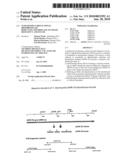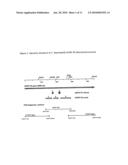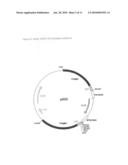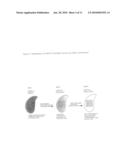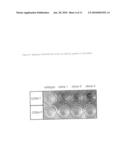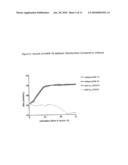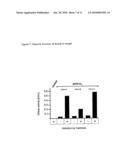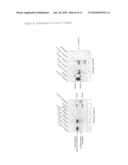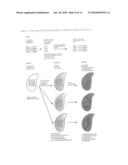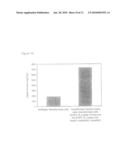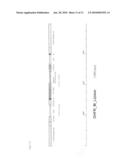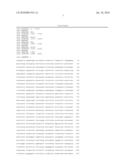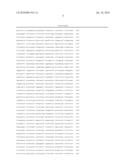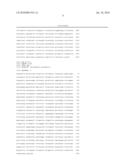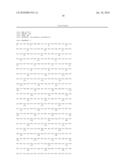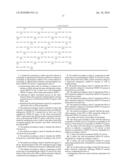Patent application title: Tetrahymena bifunctional dihydrofolate reductase-thymidylate synthase deficiency and its use
Inventors:
Thomas Weide (Altenberge, DE)
Ulrike Bockau (Munster, DE)
Marcus Hartmann (Munster, DE)
Lutz Herrmann (Herne, DE)
IPC8 Class: AC12N902FI
USPC Class:
435 25
Class name: Chemistry: molecular biology and microbiology measuring or testing process involving enzymes or micro-organisms; composition or test strip therefore; processes of forming such composition or test strip involving oxidoreductase
Publication date: 2010-01-28
Patent application number: 20100021952
Claims:
1. A method for producing a ciliate cell with reduced or essentially no
dihydrofolate reductase (DHFR) or reduced or essentially no thymidylate
synthase (TS) or both reduced or essentially no dihydrofolate reductase
and thymidylate synthase (DHFR-TS) activity, comprising the steps ofa)
transforming ciliate cells by inserting a construct containing an allele
altering the gene encoding the endogenous DHFR-TS into at least one of
the endogenous DHFR-TS genes of the ciliate macronucleus (MAC),b)
inducing an allelic assortment process in the transformed ciliate cells
to generate cells having the construct inserted in most or all functional
DHFR-TS genes of the MAC, andc) identifying the cells generated in step
b) by comparative cultivation with or without thymidine.
2. The method according to claim 1, whereby in step a) the construct containing an allele altering the gene encoding the endogenous DHFR-TS is inserted into at least one of the endogenous DHFR-TS genes of the ciliate micronucleus (MIC), and in step b) the cells having the construct inserted in most or all functional DHFR-TS genes of the MAC are generated by breeding the cells of step a) with other ciliate cells to produce progeny that contains a new MAC derived from the altered MIC.
3. The method according to claim 1, whereby the ciliate is Tetrahymena.
4. The method according to claim 3, whereby the ciliate is Tetrahymena thermophila.
5. The method according to claim 1, whereby the DHFR-TS gene has a nucleotide sequence according to Seq. ID No. 1.
6. The method according to claim 1, whereby the region 1.5 kb up- and downstream of the cell's endogenous gene coding for the DHFR-TS bifunctional enzyme is additionally altered.
7. The method according to claim 1, comprising an additional step of reconstituting the DHFR-TS activity by transfection of the cells with a DNA or RNA molecule coding for a functional non-endogenous DHFR-TS enzyme.
8. The method according to claim 1, comprising an additional step of reconstituting the DHFR-TS activity by transfection of the cells with a DNA or RNA molecule coding for a functional endogenous DHFR-TS enzyme as well as another protein.
9. The method according to claim 7, whereby the DNA or RNA molecule coding for a functional DHFR-TS enzyme is derived from an alveolate.
10. The method according to claim 7, whereby the DNA or RNA molecule coding for a functional DHFR-TS enzyme is derived from a ciliate.
11. The method according to claim 7, whereby the DNA or RNA molecule coding for a functional DHFR-TS enzyme is derived from Tetrahymena.
12. The method according to claim 7, whereby the DNA or RNA molecule coding for a functional DHFR-TS enzyme is derived from an apicomplexan.
13. The method according to claim 8, whereby the nucleotide sequence of the DNA or RNA molecule coding for a functional DHFR-TS enzyme is Seq. ID No. 1.
14. A ciliate cell with an auxotrophy for thymidine.
15. The ciliate cell according to claim 14 with reduced or essentially no DHFR activity or reduced or essentially no TS activity or both reduced or essentially no DHFR-TS activity.
16. The ciliate cell with reduced or essentially no DHFR activity or reduced or essentially no TS activity or both reduced or essentially no DHFR-TS activity, obtainable by a method according to claim 1.
17. A ciliate cell with reconstituted DHFR-TS activity.
18. A ciliate cell with reconstituted DHFR-TS activity, obtainable by a method according to claim 7.
19. A ciliate cell with reconstituted DHFR-TS activity expressing another protein, obtainable by a method according to claim 8.
20. Use of ciliate cells according to claim 17 in an assay to detect chemical compounds affecting DHFR-TS enzyme activity, comprising the steps ofa) bringing the cells into contact with the compound to be tested,b) measuring the DHFR-TS enzyme activity of the cells, andc) comparing the DHFR-TS enzyme activity to the DHFR-TS enzyme activity of control cells.
21. Use of ciliate cells according to claim 19 for the production of another protein.
22. An isolated nucleic acid coding for the DHFR-TS protein having the nucleotide sequence according to Seq ID No. 1.
23. An isolated DHFR-TS protein having the amino acid sequence according to Seq ID No. 3.
Description:
FIELD OF THE INVENTION
[0001]The present invention addresses fields of recombinant molecular biology, in particular the use of a bifunctional marker enzyme in Tetrahymena enabling selection of transformands and facilitating drug discovery in parasitic Protozoa research.
BACKGROUND OF THE INVENTION
[0002]Tetrahymena is a ciliated eukaryotic unicellular organism belonging to the regnum of Protozoa and bearing two nuclei, a transcriptionally silent, diploid germline micronucleus (MIC) and a transcriptionally active, polyploid somatic macronucleus (MAC). In 1923, when Nobel Laureate Andre Lwoff succeeded in growing Tetrahymena in pure culture, the basis for exploiting this alveolate as a model organism was laid. Milestone discoveries made in Tetrahymena are the discovery of dynein motors, telomeres, RNA-mediated catalysis, telomerase and the function of histone acetyltransferases in transcription regulation. Within the last decades molecular biological techniques have been developed to alter Tetrahymena's genome and proteome: DNA transfection methods comprise inter alia microinjection into the MAC by electroporation and biolistic bombardment of MIC and MAC. Episomal plasmids based on an rDNA-replicon are available, as well as knock-out/-in techniques based on homologous recombination. On protein level, heterologous expression of related species has been performed and also endogenous proteins were silenced by a novel antisense-ribosome-technique. The advantages of using Tetrahymena in biotechnological applications include fast growth, high biomass, fermentation in ordinary bacterial/yeast equipment, up-scalability as well as existence of cheap and chemically defined media.
[0003]So far, only a few markers that can be used in Tetrahymena have been described: ribosomal point mutation mediated resistances, a plasmid based neomycin resistance and a complicated beta-tubulin selection marker making use of an inducible promotor in combination with mutated tubulins being resistant/sensitive to the mitotic drug taxol1. Yet no true auxotrophic marker is available that permits selection without the use of antibiotics or drugs. This is where the present invention applies.
DESCRIPTION OF THE INVENTION
[0004]Critical enzymes in pyrimidine biosynthesis are the enzymes dihydrofolate reductase (DHFR) and thymidylate synthase (TS). DHFR catalyses the production of tetrahydrofolate from dihydrofolate; TS is in charge of transferring a methyl-group from N5, N10-methylene-tetrahydrofolate to dUMP thereby generating dTMP and tetrahydrofolate. These enzymes being crucial for pyrimidine synthesis have been used as auxotrophic markers in various systems by targeted gene disruption, but also a number of inhibitors (antifolates) have been developed as anti parasite drugs. In animals, fungi and eubacteria the DHFR and TS gene are separately translated, whereas plants, Alveolata and Euglenozoa have a bifunctional fusion gene with both enzyme activities combined in one protein ("DHFR-TS").
[0005]The occurrence of the bifunctional enzyme in Tetrahymena pyriformis has been postulated in 19842 and 19853 but no functional or even molecular biological analysis had been performed. A partial amino acid sequence of DHFR-TS of a non determined "T. pyriformis-like strain" has been published in 20014, but this work is lacking any proof of linkage of the described partial cDNA to enzyme function.
[0006]The present invention provides a detailed characterization of the T. thermophila DHFR-TS gene including gene structure and functional data on the enzyme including data on in vivo function. In addition to a simple auxotrophic marker that is described for the first time in ciliates, the combination of these results with certain uncommon properties of Tetrahymena yields a surprisingly powerful tool for development and discovery of new antifolates against parasitic apicomplexans like for example Plasmodium sp. (malaria), Toxoplasma gondii (toxoplasmosis) and Cryptosporidium sp. (cryptosporidiosis).
[0007]Great efforts are being made to fight these most severe worldwide problems by targeting the DHFR-TS of the above mentioned parasites by antifolates. Initial success in the fight against malaria has been overcome by the rise of drug resistant Plasmodium strains. Especially in the case of malaria the diversity of DHFR-TS is manifold due to the occurrence of different strains (P. falciparum, P. vivax, P. malariae, P. ovale) and high frequency of DNA-recombination/-mutations producing new resistances over and over again. By revealing the crystal structure of the mutated and thereby resistant DHFR-TS enzymes, new small molecule drugs are being developed by computer aided molecular modelling. The major problem is the testing of the drug candidates for efficacy: As endoparasites are difficult to culture and have an unusual complex life cycle direct testing of the new compounds is nearly impossible. A detour has been described, that makes use of dhr1 gene deficient yeast strains5 expressing the functional, parasitic DHFR-TS enzyme of interest thereby reconstituting the dhr1 deficiency. However this approach has a lot of disadvantages: The codon usage of parasitic apicomplexans, is very different from all commonly used expression-systems like E. coli, yeast and mammalian cell-lines and some tRNAs needed for translation are not abundant in these model organisms. Apicomplexa/Sporozoa, belonging to the phylogenetic group of Alveolata, possess a number of special cell biological features, the most notable being the presence of cortical alveoli, flattened vesicles packed into a continuous layer supporting the membrane. No model organism described so far has this assortment of special properties that will influence drug uptake and virtue.
[0008]All the problems mentioned above can be overcome by the use of Tetrahymena:
[0009]It belongs to the Alveolata and is the most closely related species to apicomplexans. Tetrahymena is capable of growing in chemical defined media without the presence of thymidine arguing for a functional salvage pathway for dTMP synthesis by a bifunctional DHFR-TS enzyme. Deficiency in this enzyme activity should yield cell lines that only grow in media supplemented with thymidine. To destruct DHFR-TS activity various common techniques can be used like e.g. targeted gene knockout, site directed mutagenesis of essential amino acids and random mutagenesis. Screening for DHFR-TS deficient clones can be performed by replica plated culturing in media with (T+) or without thymidine (T-). Potential clones should only grow in T+but not in T-. Successful reconstitution of enzyme activity can be achieved by transforming aforementioned cells with DNA fragments encoding for a functional DHFR-TS enzyme yielding cells that will grow on T-. This method allows selection of transformands without using drugs or antibiotics. In case of the exogenous, recombinant DHFR-TS being derived from parasitic apicomplexans an ideal model system for antifolate drug screening is achieved that can readily be used in a high throughput system.
[0010]A method for producing a ciliate cell with reduced or essentially no dihydrofolate reductase (DHFS) activity or reduced or essentially no thymidylate synthase (TS) activity or both reduced or essentially no dihydrofolate reductase and thymidylate synthase (DHFR-TS) activity is claimed, comprising the steps of [0011]a) transforming ciliate cells by inserting a construct containing an allele altering the gene encoding the endogenous DHFR-TS into at least one of the endogenous DHFR-TS genes of the ciliate macronucleus (MAC), [0012]b) inducing an allelic assortment process in the transformed ciliate cells to generate cells having the construct inserted in most or all functional DHFR-TS genes of the MAC, and [0013]c) identifying the cells generated in step b) by cultivation with or without thymidine.
[0014]The method according to the invention can also utilize the fact that the micronucleus (MIC) stores the genetic information for sexual progeny. Consequently the method according to the invention also encompasses that in step a) the construct containing an allele altering the gene encoding the endogenous DHFR-TS is inserted into at least one of the endogenous DHFR-TS genes of the ciliate micronucleus (MIC), and in step b) the cells having the construct inserted in most or all functional DHFR-TS genes of the MAC are generated by breeding the cells of step a) with other ciliate cells to produce progeny that contains a new MAC derived from the altered MIC.
[0015]According to the invention it can be preferred that the ciliate is Tetrahymena, preferably Tetrahymena thermophila.
[0016]The DHFR-TS gene according to the invention can have a nucleotide sequence according to Seq ID No. 1.
[0017]It may be preferred that the region 1.5 kb up- and downstream of the cell's endogenous gene coding for the DHFR-TS bifunctional enzyme is additionally altered.
[0018]The method according to the invention can comprise an additional step of reconstituting the DHFR-TS activity by transfection of the cells with a DNA or RNA molecule coding for a functional non-endogenous DHFR-TS enzyme.
[0019]The term "non-endogenous" means that the DNA or RNA molecule is derived from a different organism, preferably from a different alveolate species.
[0020]Furthermore the method according to the invention can comprise an additional step of reconstituting the DHFR-TS activity by transfection of the cells with a DNA or RNA molecule coding for a functional endogenous DHFR-TS enzyme as well as another protein.
[0021]The DNA or RNA molecule coding for a functional endogenous or non-endogenous DHFR-TS enzyme can be derived from an alveolate, preferably a ciliate, even more preferably from Tetrahymena and most preferably from Tetrahymena thermophila. It may also be derived from an apicomplexan.
[0022]Furthermore the DNA or RNA molecule coding for a functional DHFR-TS enzyme can be represented by Seq. ID No. 1 and the amino acid sequence of the enzyme can be represented by Seq. ID No. 3.
[0023]The present invention also comprises a ciliate cell with an auxotrophy for thymidine. Preferably the ciliate cell according to the invention has reduced or essentially no DHFR activity or reduced or essentially no TS activity or both reduced or essentially no DHFR-TS activity. Said ciliate cell may be obtainable by using the methods as described herein.
[0024]A ciliate cell with reconstituted DHFR-TS activity is also disclosed, whereby the DHFR-TS enzyme is not the endogenous form. Said ciliate cell may be obtainable by using the methods as described herein.
[0025]Furthermore the present invention encompasses a ciliate cell with reconstituted endogenous DHFR-TS activity expressing another protein. Said ciliate cell may be obtainable by using the methods as described herein.
[0026]The use of the ciliate cells according to the present invention having a reconstituted non-endogenous DHFR-TS enzyme activity in an assay to detect chemical compounds affecting DHFR-TS enzyme activity is also claimed, comprising the steps of [0027]a) bringing the cells into contact with the compound to be tested, [0028]b) measuring the DHFR-TS enzyme activity of the cells, and [0029]c) comparing the DHFR-TS enzyme activity to the DHFR-TS enzyme activity of control cells.
[0030]The ciliate cells according to the invention having a reconstituted endogenous DHFR-TS enzyme activity can be used for the production of another protein.
[0031]An isolated nucleic acid coding for the DHFR-TS protein having the nucleotide sequence according to Seq ID No.1 and an isolated DHFR-TS protein having the amino acid sequence according to Seq ID No. 3 is also within the scope of the present invention.
[0032]FIG. 1: Genomic structure of T. thermophila DHFR-TS bifunctional enzyme
[0033]The DHFR-TS gene structure of T. thermophila consists of three exons (grey) and 2 introns (black). Primer pairs to amplify DNA for homologous integration and to amplify the CDS or cDNA are shown in the bottom part.
[0034]FIG. 2: pKOI: DHFR-TS knockout construct
[0035]FIG. 2 shows the knockout construct used for a targeted knockout of the DHFR-TS gene in T. thermophila. It consists of 3' and 5' flanking regions of the T. thermophila DHFR-TS gene and parts of its coding sequence (CDS), disrupted by a functional neomycin cassette conferring resistance to paromomycin.
[0036]FIG. 3: Generation of DHFR-TS deficient strains by allelic assortment
[0037]Wildtype strains are transfected with pKOI. In one copy of the 45 ARPs the endogenous DHFR-TS gene is substituted by the knock out construct (step 2). By amitotic division of the MAC and high selection pressure clones will arise that have sorted out all endogenous DHFR-TS genes and retain only recombinant and defect DHFR-TS genes (step 3).
[0038]FIG. 4: Selection of DHFR-TS knockout cells by growth on thymidine
[0039]Tetrahymena cells with disrupted DHFR-TS gene (clone 1-3) do not grow without the presence of thymidine (CDM-T), whereas wildtype cells do. Addition of thymidine to the medium (CDM+T) recovers growth.
[0040]FIG. 5: Growth of DHFR-TS deficient Tetrahymena compared to wildtype
[0041]Growth kinetics of DHFR-TS knock out cells compared to wildtype cells in media with or without thymidine show that the knock out strain (pKOI) is growing as fast as wildtype cells on thymidine supplemented media (CDM+T). Knock out cells die without thymidine present (CDM-T). The curves are calculated by mean values of at least three independent experiments.
[0042]FIG. 6: Proper integration of DHFR-TS knockout construct
[0043]This figure points up the PCR approach to determine that the knock out/in construct has integrated into the DHFR-TS gene locus.
[0044]Three different cells were tested: K1 is a wildtype control, K2 are cells transfected with a plasmid carrying only the disrupting cassettes but no DHFR-TS gene sequences and pKOI DVL are cells transformed with the pKOI DVL plasmid. PCR1 is a control reaction amplifying 369 bp of the beta-hexosaminidase gene. PCR2 is to detect endogenous DHFR-TS (note that in the pKOI DVL cells there still is a wildtype gene in the MIC!). PCR3 only yields PCR-product for correctly integrated pKOI DVL DNA. PCR4 shows that the full-length expression cassette has integrated.
[0045]FIG. 7: Enzyme function (DNase) of knock in target
[0046]Supernatants of three clones transformed with pKOI DVL were assayed for DNase activity. Only induced cells (+) show high levels of DNase activity. Transformed, but uninduced cells show a slightly elevated enzyme activity compared to wildtype cells due to low basal promotor activity.
[0047]FIG. 8: Expression of knock in target
[0048]Western blots show expression of recombinant human DNase I: Only transformed and induced cells (+) show strong signals due to anti-DNase I antibodies. The intracellular PLA1-DNase-fusionprotein is visualized on the left blot by samples of cell lysates. Bands are running at higher molecular weight than the mature and processed positive control. On the right, supernatants were subjected to western blot; the size of the secreted protein of Tetrahymena argues for a correct processing when compared to the positive control.
[0049]FIG. 9: Overview reconstitution of DHFR-TS activity by knock in
[0050]Step I shows the constructs needed for homologous recombination of different exogenous DHFR-TS genes into the disrupted Tetrahymena DHFR-TS gene locus. The strain described in example 1 is transfected with these DNAs enabling selection by medium deficient of thymidine (step III). After allelic assortment stable cell-lines with different recombinant DHFR-TS properties are obtained (step IV) that can be used in antifolate drug screening.
[0051]FIG. 10: Enzyme (endogenous lipase) function of knock in target
[0052]Comparable to FIG. 6 the gene of an endogenous Ciliate-Lipase were combined with an inducible promoter and flanking regions of the Tetrahymena DHFR-TS gene. Subsequently the construct was integrated in a transformation vector (construct called pKOIX_M_Lipase) and transformed into Tetrahymena. After homologous integration of DHFR-TS construct into Tetrahymena DHFR-TS locus and following selection of the clones (comparable to the described procedure in FIG. 3-FIG. 6), supernatants of one clone transformed with pKOIX_M_Lipase were assayed for Lipase activity. Only cells, that have integrated pKOIX_M_Lipase construct, show high levels of Lipase activity. Wildtype cells show a low level of Lipase enzyme activity due to low promoter activity of the endogenous Lipase promoter. The lower graph shows the full-length integrative construct. FIG. 10 shows the Lipase activity in the supernatant of wildtype cells and induced transformants measured with a Lipase enzyme assay according to the Reflectoquant® lipase test instructions of the manufacturer.
[0053]FIG. 11:
[0054]FIG. 11 shows the construction of the full-length integration/expression cassette for lipase (pKOIX_M_Lipase), which was transformed into Tetrahymena cells in order to obtain over-expression of endogenous Ciliate-Lipase.
EXAMPLES
[0055]The following examples are provided to illustrate the embodiments of the present invention, but are not intended to limit its scope.
Cells and Cell Culture
[0056]Tetrahymena thermophila strains B 1868.4, B 1868.7 and B 2068.1 were kindly provided by Peter J. Bruns and cultivated in skimmed milk medium (2% skimmed milk, 0.5% yeast extract, 0.1% ferrous sulphate chelate solution and 1% glucose) in SPP or in CDM medium.
Amplification of the DHFR-TS Gene of T. Thermophila
[0057]The DHFR-TS cDNA gene and its 5' and 3' flanking sites can be amplified using the following primer pairs. Nucleotides in small letters encode sites for restriction endonucleases.
Amplification of the DHFR-TS 5' Flanking Region:
TABLE-US-00001 [0058]DHFR 5'1 F NotI: 5'-cccgcggccgcACAGAGTTAATGGAAAT GGAGC-3', DHFR 5'2 R BamHI: 5'-gggggatccATATTTAAGCGATCTTTC AATGG-3;
Amplification of the DHFR-TS cDNA and Gene with Introns:
TABLE-US-00002 DHFR CDS F: 5'-cgcGAATTCATGAAAACAAGACATTTTGATATA GTTTTAGC-3', DHFR CDS R: 5'-gcgCTCGAGTCAGACAGCCATTTTCATTTATAT TTTAGGG-3',
Amplification of the DHFR-TS 3' Flanking Region:
TABLE-US-00003 [0059]DHFR 3'1 F XhoI: 5'-gggctcgagATGCTCATGTTTACTCTAA TCACG-3', DHFR 3'1 R Acc65I: 5'-gggggtaccAGTAAAAATAGAGTAGA AGGAG-3'.
Construction of Plasmids
[0060]The pKOI (knock out/in) plasmid was constructed as follows: As backbone for selection and propagation in E. coli the pBS II SK plasmid was used. The 1.5 kb 5'-DHFR-TS integration site was amplified using the primer pair DHFR 5' 1 F NotI and DHFR 5' 2 R BamHI cloned into pBS II SK by using NotI and BamHI sites. Next the 1.4 kb paromomycin selection cassette from the pH4T2 (neo2) was cloned into the intermediate pBS IISK by BamHI and SmaI sites. Finally, the 3'-DHFR-TS integration site was amplified by primers DHFR 3' 1 F XhoI and DHFR 3' 1 R Acc65I and cloned by using the XhoI and Acc65I sites to finish the DHFR-TS knock out cassette.
[0061]The SacI site of the pBS II SK backbone had been destroyed by site directed mutagenesis to facilitate the use of the endogenous SacI site in the 3'-DHFR-TS integrating sequence and the XhoI site as unique cloning site in pKOI. These sites were used to insert cassettes for the expression of recombinant enzymes (knock in). In this study we used a human recombinant DNase I expression/secretion cassette and a Ciliate-endogenous lipase expression/secretion cassette. For DNase it consists of the first 115 aa of the endogenous PLA1 precursor and the aa 23-281 of the mature human DNase I. To ensure proper translation of this fusion protein a codon optimised synthetic human DNase I gene was used. The expression was controlled by the previously described6 inducible MTT-1 promotor, termination is regulated by the BTU2 terminator, like in the neo2 cassette of pH4T27.
Transformation of pKOI Plasmids (Biolistic Bombardment)
[0062]We used conjugating cells, as well as vegetative, growing and non-conjugating stationary T. thermophila strains. The transformation of the T. thermophila cells was performed as previously described by Gaertig et al8.
Selection, Allelic Assortment and DHFR-TS Knock Out Assay
[0063]T. thermophila cell proliferation assay: For the first ca. 16 h after biolistic bombardment transformants were grown in skimmed milk medium. After that transformed cells were grown on SPP medium with in increasing concentrations of paromomycin (from 100 μg/mL to 1000 μg/mL) to support the allelic assortment process. After 3-4 weeks each clone was cultivated on CDM replica plates with or without thymidine (10 mg/mL). Functional DHFR-TS knock out clones are only able to grow in CDM medium supplemented with thymidine. The viability of the DHFR-TS knock out strains was monitored by determining the growth kinetic (FIG. 5).
[0064]The lack of the endogenous wildtype DHFR-TS gene in the MAC as well as the complete integration of the DHFR-TS knock out and rhDNase I knock in cassette was confirmed by PCR using the following primers:
TABLE-US-00004 DHFR01F: 5'-CTTTTTAACAGCCTGCTGCTCG-3', DHFR02R: 5'-GATTTTGATGCTTCAATAAGGTTG-3', DHFR03F: 5'-TTATTTGTTTTATCATAGTGGAAAAGG-3', DHFR04R: 5'-CAGACACCTCAATCATATCAAAG-3', DHFR05F: 5'-GGTCCTCCATCAGATTGTGG-3' DHFR06R: 5'-CGCGTCGAGTCAGACAGCCATTTTCATTTA-3' Hex01F: 5'-ATGCAAAAGATACTTTTAATTACTTTC-3' Hex02R: 5'-TATATTTTAGGAATGTTGTAATC-3'
[0065]A pH4T2 plasmid carrying the same neo2 and DNase I expression/secretion cassettes was used a PCR control. The PCR strategy is illustrated in FIG. 6.
SDS-PAGE and Western Blot
[0066]Aliquots of transformed cells and of SPP supernatants were resuspended in sample buffer and separated on 15% SDS-PAGE. The gels were blotted onto nitrocellulose membranes and blocked in PBS containing 0.05% Tween 20 and 5% skim milk (PBS-TM). The expression of recombinant human DNase I in transformed Ciliates was detected by two specific anti sera from rabbit against human DNase I (antigen: recombinant human DNase I, Pulmozyme, Roche). Both sera detected the recombinant DNase I antigen. The serum was used in a 1:500 dilution in PBS-TM. After washing with PBS/T an HRP-conjugated anti rabbit serum was applied. The blots were developed by using chemiluminescence.
DNase I Activity Assay
[0067]The methyl green based DNase activity assay was performed as already published9. Samples were incubated at 37° C. for 24 h on a microtiter plate. Absorbance was measured at 620 nm. Calibration of the assay was achieved by different amounts of defined DNase I Units of Pulmozyme from Roche (CHO derived) in each experiment and linear regression. These results combined with semi-quantitative western blotting were used to calculate the specific activity of expressed DNase I.
Lipase Activity Assay
[0068]The Lipase activity assay (Reflectoquant® test strips together with the Reflectometer RQflex®) was performed according to the instructions of the manufacturer (VWR International GmbH, Hilpertstraβe 20a, 64295 Darmstadt, Germany, article number: 1.05851.0001).
Example 1
Generating Auxotrophic Heterokaryons
[0069]The protozoan T. thermophila belongs to the ciliates. These eukaryotes consist of two nuclei, a somatic macronucleus (MAC) and the genetic micronucleus (MIC). The MIC is the germline nucleus, i.e. it stores the genetic information for sexual progeny. The MIC is diploid and contains five pairs of chromosomes. In contrast to this the MAC is the somatic nucleus and no MAC DNA is transmitted to sexual progeny. The MAC contains 200-300 autonomously replicating pieces (ARP) that are derived from the MIC. Each of these units is present at about 45 copies except for the rDNA gene that is independently amplified to ca. 10000 copies per cell. The MAC DNA is the transcribed DNA and therefore responsible for the actual phenotype of T. thermophila cells.
[0070]It is obvious that genetic engineering ultimately needs the transformation of the functional MAC that is in charge of protein expression. The first approaches for heterologous expression were done by using plasmids that use the vast amplification of the rDNA gene during MAC development. However the episomal presence of these plasmids depends on the drug concentration and the plasmid may recombine homologously and non-directionally into endogenous rDNA units.
[0071]The more promising way is the stable transformation of cells. This means the stable integration of expression cassettes into the MAC and or/the MIC of T. thermophila. MIC transformation can be achieved by stably transforming the chromosomal DNA of the diploid MIC. After conjugation of two different mating types the old MACs of the conjugating cells disappear and new MACs were built in the progenies derived from the recombinant MICs that carry the new information. The whole process follows the statistics of the Mendelian genetics. The advantage of this approach is that one obtains stable clones that maintain the genetic properties and that can be crossed via classical genetics to combine various properties of different T. thermophila strains. This approach is very elaborative and time consuming. Furthermore, it was shown recently that scan RNAs derived from the old MAC play an important role in DNA elimination during the development of the somatic MAC from the germline MIC. The primary sequence of these small RNAs explains how the parental MAC epigenetically controls the genome rearrangement in the new MAC. In the case of stable MIC transformants this RNAi-like mechanism inhibits the establishment and maintenance of foreign expression cassettes in the developing new MAC.
[0072]Instead of episomal transformation by rDNA based plasmids or the stable transformation of the MIC a shortcut by the combination of stable MAC transformation with an immediate allelic assortment approach was used. This combination has several advantages. Firstly, the MAC transformation is much more efficient because there are at least about 45 potential integration sites per gene locus. Secondly, not only conjugating but also non-conjugating and therefore defined strains can be transformed. Finally, the recently reported genome rearrangements in the developing MAC that are regulated by scan RNA mechanisms can be short-circuited by MAC-transformation combined with allelic assortment.
[0073]To perform knock out/in experiments the T. thermophila DHFR-TS gene and its flanking regions were amplified by using the primer pairs DHFR 5'1 F Not, DHFR 5'2 R BamHI for the 5' region non coding region, the primer pair DHFR 3'1 F XhoI: 5, DHFR 3'1 R Acc65I for the 3' region and the primers DHFR CDS F, DHFR CDS F for amplification of the coding region. The comparison of the coding region of the DHFR-TS structure gene to the DHFR-TS cDNA (amplified by the same DHFR CDS F/R primer pair) revealed the exon-intron architecture of the structure (FIG. 1).
[0074]To start the DHFR-TS knock out experiments the plasmid pKOI was constructed (FIG. 2). The neo2 cassette of pH4T2 was used to monitor the successful uptake of the plasmid by selection against paromomycin. The neo2 cassette of pKOI is flanked by the 1.5 kb fragments of the 5' and 3' region of the non-coding regions of the DHFR-TS gene, respectively (FIG. 2). Because pKOI lacks an appropriate origin of replication, paromomycin resistant T. thermophila clones argue for a proper homologous recombination event in the DHFR-TS gene locus. Nevertheless, the most convincing evidence for the correct integration into the DHFR-TS locus is a loss of the DHFR-TS activity in the transformed strain. In the case of ciliates this requires the all complete replacement of all chromosomal DHFR-TS wildtype alleles (˜45 ARPs) by the ARPs that includes the knock out cassette. We achieved this by allelic assortment. This allelic or phenotypic assortment is based on randomised distribution of the MAC chromosomes units (ARPs) during mitosis. In order to force the assortment process into the desired direction--namely into the recombinant resistance gene--the transformed cells were cultivated for at least 2-3 weeks using increasing concentrations of the drug paromomycin. Single clones were isolated and tested for DHFR-TS deficiency by using a minimal chemical defined medium (CDM) with (+T) and without thymidine (-T). In FIG. 4 and FIG. 5 it is demonstrated that the found DHFR-TS knock out clones are real auxotrophic strains: The mutants are able to grow in CDM with thymidine like wildtype strains or strains with an incomplete allelic assortment. In CDM lacking thymidine they are unable to grow (see FIG. 4 and FIG. 5).
Example 2
Knock Out DHFR-TS to Knock in the Gene of Interest
[0075]The knock out of the endogenous DHFR-TS gene of T. thermophila also provides the possibility to knock in a further foreign gene that can be expressed heterologously in the DHFR-TS knock out strains. For this purpose the pKOI DVL plasmid was constructed. It consists of a pKOI backbone with an additional expression cassette that encodes the first 115 amino acids (aa) of the precursor sequence of the PLA1 gene and the mature human DNase I (amino acids 23 to 281). Construct for the expression of the endogenous lipase contains the endogenous-Ciliate-lipase-prepro peptide sequence and the mature endogenous Ciliate-lipase.
[0076]The PLA1 prepro peptide (aa 1 to 110) has significant similarity to members of the cathepsin L family and mediates secretion into the medium. Similar to PLA1 prepro peptide the endogenous-Ciliate-lipase prepro peptide mediates the secretion of the lipase into the medium.
[0077]In the case of the DNase the five additional amino acids (aa 111 to 115) should ensure an optimal cleavage of the pro PLA1-DNase I fusion protein by endogenous pro-peptidases. In contrast to the neo2 cassette the expression of the ppPLA115-DNase I fusion protein is regulated by the inducible MTT1 promotor. The inducible system was selected because it allows a clear discrimination between the DNase activity of heterologously expressed recombinant human DNase I and the basal activity due to at least two endogenous DNases. According to this the inducible system was also selected in the case of Lipase because it allows a clear discrimination between the basal level of the endogenous Lipase activity and homologous overexpressed endogenous Lipase acitivity. The transformation, selection of positive clones and the directed allelic assortment were done as outlined in example 1. Furthermore, the correct and complete integration of both expression cassettes (neo2 and the DNase I) in the DHFR-TS locus was tested by a PCR approach. FIG. 6 shows that this is the case.
[0078]In order to demonstrate the pKOI concept, cells of these DHFR-TS knock out strains carrying the ppPLA115-DNase expression cassette were treated with and without Cadmium. Only induced strains showed an elevated DNase activity in the supernatant (FIG. 7). To confirm this enzymatic data a specific antiserum against human DNase I was used to analyse the cell extracts and the supernatant of these human DNase expressing DHFR-TS knock out strains by western blot. The results illustrate that the DHFR-TS knock out strains are capable of expressing and secreting the functional recombinant human protein (FIG. 8).
Example 3
Recombinant Reconstitution of DHFR-TS Activity to Create Strains for High Throughput Antifolate Screening
[0079]The reconstitution of the DHFR-TS activity in DHFR-TS deficient Tetrahymena strains can be done by heterologously expressing bifunctional DHFR-TS enzymes of other Alveolata. As already mentioned in the introduction, this phylogenetic group consists of the Ciliata, Dinoflagellata and Apicomplexa/Sporozoa. Especially the Apicomplexa are of high medical interest because all members are intracellular parasites and some of them cause very severe diseases (malaria, toxoplasmosis, cryptosporidiosis).
[0080]Apart from the fact that DHFR-TS deficient T. thermophila strains in combination with a DHFR-TS plasmid/vector provide a new marker for molecular biology, the same system can be used to generate defined test strains for drug development applications. Due to the close phylogenetic relationship it is also possible to recover the DHFR-TS activity in deficient Tetrahymena strains by DHFR-TS enzymes from other members of the Alveolata group. This implies the application of DHFR-TS deficient T. thermophila strains in searching for and testing novel anti DHFR-TS drugs (antifolates). This is of very high importance because antifolates have been one of the most promising drugs in the fight against malaria. The fact that anti DHFR-TS drugs have been administered for a long time in e.g. malaria patients is the reason that during the last decades many of the parasites became resistant. At present many approaches are being explored to find new and more specific and efficient drugs against the parasite DHFR-TS enzyme. As the search for new antifolates relies on structure determination using NMR and crystallization techniques, most of these approaches are very time and cost intensive.
[0081]DHFR-TS deficient T. thermophila strains that express an active parasite DHFR-TS will not only be able to grow in medium lacking thymidine, but they are also suitable to search for novel antifolates. Thus the DHFR-TS deficient strains recovered by the homologous bienzyme of the parasites represent a simple and flexible in vivo test system conferrable to other disease causing parasites of the Apicomplexa group. For example antifolates against Plasmodium vivax strains have not been considered because no appropriate and flexible in vivo system for high throughput approaches was available. This can be done easily by recovering the DHFR-TS activity of T. thermophila strains by using the homologous bienzymes of Plasmodium vivax, Plasmodium malariae, Plasmodium ovale as well as enzymes from Apicomplexa/Sporozoa that cause toxoplasmosis or cryptosporidiosis. FIG. 9 illustrates this concept. The DHFR-TS enzyme of the pyrimethamine-sensitive Plasmodium falciparum strain 3D7 was used to recover the DHFR-TS activity in a T. thermophila strain, lacking DHFR-TS activity. In parallel a DHFR-TS from a Plasmodium falciparum strain that is resistant against the pyrimethamine treatment (for example the DHFR-TS S108N mutant) is tested. By measuring the effect of pyrimethamine in dose response curves on the two different transformands drug resistance and sensitivity can be determined easily. Subsequently new potential drugs can be added to the medium to show effectiveness on yet resistant DHFR-TS mutants.
REFERENCE LIST
[0082]1. Gaertig, J., Thatcher, T. H., Gu, L. & Gorovsky, M. A. Electroporation-mediated replacement of a positively and negatively selectable beta-tubulin gene in Tetrahymena thermophila. Proc. Natl. Acad. Sci. U.S.A. 91, 4549-4553 (1994). [0083]2. Garrett, C. E. et al. A bifunctional thymidylate synthetase-dihydrofolate reductase in protozoa. Mol. Biochem. Parasitol. 11, 257-265 (1984). [0084]3. Kotsifaki, H., Kapoulas, V. & Deliconstantinos, G. Targeting of liposomes containing methotrexate towards Tetrahymena pyriformis cells. Gen. Pharmacol. 16, 573-577 (1985). [0085]4. Stechmann, A. & Cavalier-Smith, T. Rooting the eukaryote tree by using a derived gene fusion. Science 297, 89-91 (2002). [0086]5. Hastings, M. D. & Sibley, C. H. Pyrimethamine and WR99210 exert opposing selection on dihydrofolate reductase from Plasmodium vivax. Proc. Natl. Acad. Sci. U.S. A 99, 13137-13141 (2002). [0087]6. Shang, Y. et al. A robust inducible-repressible promoter greatly facilitates gene knockouts, conditional expression, and overexpression of homologous and heterologous genes in Tetrahymena thermophila. Proc. Natl. Acad. Sci. U.S. A 99, 3734-3739 (2002). [0088]7. Gaertig, J., Gu, L., Hai, B. & Gorovsky, M. A. High frequency vector-mediated transformation and gene replacement in Tetrahymena. Nucleic Acids Res. 22, 5391-5398 (1994). [0089]8. Gaertig, J. & Gorovsky, M. A. DNA-mediated transformation in Tetrahymena. Methods Cell Biol. 47, 559-569 (1995). [0090]9. Sinicropi, D., Baker, D. L., Prince, W. S., Shiffer, K. & Shak, S. Colorimetric determination of DNase I activity with a DNA-methyl green substrate. Anal. Biochem. 222, 351-358 (1994).
Sequence CWU
1
314556DNATetrahymena
thermophila3'UTR(1)..(1760)CDS1(1346)..(1760)Intron(1761)..(1839)CDS2(184-
0)..(2190)Intron(2191)..(2302)5'UTR(2995)..(4556) 1acagagttaa tggaaatgga
gctatgattg tcagtccttc tcgtgttcct cagagaggtg 60gtgctattgg aactagacag
aacttacctg atactatgta gcatattttc gctacaaacc 120attaaatata acagccccag
acagtagaag atttgcaaag aatggaagaa atataaagaa 180atatagaaaa cgaaaacaat
atttatagta ataataccca taataatata gaaaatccag 240agaatgaaaa ttaggaatcg
cgagtaaact aagttcctac tttcctataa aacaactaat 300tttaaataaa caacatttct
gataaaaaaa aatgagctaa ttgacaacct cgcctatcta 360caaacaaata agttgtatta
gctaattatt ctttacttac tcttctacta aaattttaat 420ctaataaata aatttatata
atcaaaaaca attttcttga tctgaagtaa atagcatgtc 480cgccacctct aaaaataatc
aaaataaaaa atacataaaa tttaagcaaa ttcaaaaaaa 540ttcttaaaaa aaagaatgaa
tgaatgaatg aagatggata caaagagcta tcaaaaaaga 600aataactaat agaataattt
attaaaatct ataaaatcat agatctaatt ccagtttttt 660tcttctacga aagtgaaagt
tagttttata agattgatag aaagatattt gtatctatta 720gcattaaaat agaattaaga
tcttctaaga tattctctat ccctacctta tacctctctt 780ttactaatat acctataata
aataacatct acttattaat ttatgatact ccttttattc 840aaaattatta actaaaataa
aaatttatta cagaaatctt acttttaaat tctaaaagtt 900aagcttctaa ttactattaa
ataaataaat aatatatatt tatcttgtat tttgtaaaaa 960tatttcactt ttattgccat
ttcagttcat tctatttatt catttctata ctttttgcta 1020ttaacttaat aaaatatatt
ttatactatg aaaatttact ttgttaagtt gagagaattt 1080aattcttttt ataaaaaatc
tatcttgaga ttactctagt atcatctaaa aatcaaaaat 1140agctatttat aatttattgg
cgcaatcctt aaaagatcgc gggtattatg aatcactaac 1200tcattcactg gcttgcatcg
cttaactttg aatttagctt atatatccgc tatattttta 1260caaatcaaat tttaatttat
aaaataagtg aaaagtaaat tgaaattaaa aatagaaatt 1320taacaaataa acagactcag
tataaatgaa aacaagacat tttgatatag ttttagctta 1380gactttaaaa aaatagggta
taggttataa gaacagttta ccatggagac tacctaatga 1440gcttaaaaac tttaaaaaaa
taactacaga aactaagaac aaaggcctat aaaacgctgt 1500tatcatgggt aaaaatactt
gggaagcact acctaaaaag caataaccat tgaaagatcg 1560cttaaatatt gttatttcca
ctactatgca agaggggtaa attgcagatc attcctacgc 1620ctgtaaaagc ttagattctg
ctttaaactt tttagaatag taaaattaaa tataagatgc 1680ccttgtaatt ggaggagcta
aactttgcca ataagcatta agcgatcaga gacttagata 1740gattcatcta acaagagtag
gtcagtagaa ttaaatttat taaatacttt ctttttatga 1800acaaaagaga taattaaata
acttttcaaa aatatttagg tgtcgaagtt gagtgcgatg 1860tttttatgca aaaggactac
ttaaaaaact ttgatatgat tgaggtgtct gaaacttaaa 1920gcgaaaataa tttaaattat
gattttacta ggtattttaa taagaattat aaaggataag 1980ttgacccttc tctctttaag
aaaatgtaca agcctcatca agaatattaa tacttagaac 2040ttatcgatga aattataaag
aatggacatg ttaaaacaga cagaactgga actggtacaa 2100tttctcagtt tggcaagttg
atgagatttg acttatcaaa gagttttcct ctgcttacta 2160ccaaaaatgt tttttggaga
ggtgtagtag aagtaataaa tatatttatt tatttattaa 2220tttatagttt gatagattta
aaaatgaaat ttagtctgat ttttagtaga ataaataaaa 2280taatctaaat atataaatta
ataggaactt atttggttta tcaaaggcag tacaaacagc 2340aaaatacttt cagaaaaagg
agttaaaata tgggacggta atggcagcag agaattttta 2400gattaattag gctttaaaaa
cagagaagaa ggagatttag gtcctgttta tggtttctaa 2460tggagacact tcggtgctga
atataaagat atgcatacaa attataaagg taaaggtgtc 2520gaccagcttc aagatttaat
taacacaata aagaaaaatc ctgacagcag aaggatgatt 2580atgaatgcct ggaatgttaa
agatctacca ttgatggctt tacctccttg tcatgtcatg 2640agctagtttt atgtaaatga
taataaacta agctgtatga tgtactaaag atcttgtgat 2700atgggtttag gaataccatt
taatatagcc agttatgctt tattgactca tatgatagct 2760taagtcacta atatgtaagt
tggagagttt atacatgttc taggtgatgc tcatgtttac 2820tctaatcacg tagattaact
aaaaatttaa ttagaaagag ctccataccc cttccctctt 2880ttaaaaatta ataacaacaa
gtaatataac tctattgaag acttcactct tgaagatttc 2940gaattaattg gatacaacta
tcaccctaaa atataaatga aaatggctgt ctgaaatgat 3000taaagactta tatattttgg
ataatcttac tactaaaata ctaactaact taaatggtta 3060tatacaataa atctatctta
ataagctatt ttaaatttta aatcaatcgt tcaattcttt 3120attttataaa ctttcaaatc
attatcaagc aaattttaaa taaatatttt ttttttatat 3180attgttgaac ttttgttcag
cctgaatggc atagagctaa gtaattgtaa agttgaaaca 3240ttaaaaatca aaattcaata
gaaaatttgg aaaaagaatt ttttatttag ttagaaataa 3300aacaaattat ttatataatt
ttttatagtt gattgatata tttatttatt taatttcata 3360tttagagtga gcataatctt
aggcacttta aaagctaagc tctaattaat tttagatttt 3420atttgaatct ttatattata
aaaatattaa atattattgt agaaaataga atttaattac 3480tgaataggca tctttataga
ttataatttt ctaaactttc tgattttgtt tgatatattt 3540attaaatgat cataatttac
ctaattatgt ctataaatag agtaaaaata tcatttttta 3600agagtaataa tttactataa
gtcaatctat aatccaacta aacttggtaa tttactcaaa 3660ttttcaataa gttcttatac
ttaatcattt cctaaatggc aattactaat tattattttg 3720taatgaaaat taaatatata
taataaaatc actaattaat ttaccttaaa cctaaattta 3780aatattttaa acagctgaat
tgagtgagta tagaagctat cgacaaaaca cattctttac 3840atccaatatt atcactgttg
ttttatattt tataatttaa ataaaaatct tataaaacaa 3900tttaattaat tttactctaa
attaaattat agtttattta attgattaaa tctacatagc 3960tactctttaa aagcctgtgc
ataactagtg cctatataat tatacctatc aataatttaa 4020tttttagtaa ttataattaa
ataagaattt actataattg aagggtaagg tttctaatag 4080actaaaattc ggtaagtcca
tttatgatat tattcaatga tttctaggag agagaacatt 4140tacttaataa tatttaacag
attaatttta aatctttttt aaaaaattct actttaatga 4200taagtttaat tcagatagct
acttacagaa attaactgtg tttattgaca attcttaatt 4260aaattctatt ttattttcac
taatttaata aaaaaaatag ctaaaaataa aatttttaat 4320taaaataatt atactccaaa
actagttcta gcttttttaa gctttaaaat tcacttaaat 4380attcaaatac ttaagatata
tctccttcta ctctattttt acttaataga ataattttta 4440tatcataact cttaaaaact
aaaattacct caacaaaaac gttagatttt caagatattg 4500attttatttt agcttcaaaa
aaaagtatta aagcccttct ttgcttattt aattgt 455621458DNATetrahymena
thermophila 2atgaaaacaa gacattttga tatagtttta gcttagactt taaaaaaata
gggtataggt 60tataagaaca gtttaccatg gagactacct aatgagctta aaaactttaa
aaaaataact 120acagaaacta agaacaaagg cctataaaac gctgttatca tgggtaaaaa
tacttgggaa 180gcactaccta aaaagcaata accattgaaa gatcgcttaa atattgttat
ttccactact 240atgcaagagg ggtaaattgc agatcattcc tacgcctgta aaagcttaga
ttctgcttta 300aactttttag aatagtaaaa ttaaatataa gatgcccttg taattggagg
agctaaactt 360tgccaataag cattaagcga tcagagactt agatagattc atctaacaag
agtaggtgtc 420gaagttgagt gcgatgtttt tatgcaaaag gactacttaa aaaactttga
tatgattgag 480gtgtctgaaa cttaaagcga aaataattta aattatgatt ttactaggta
ttttaataag 540aattataaag gataagttga cccttctctc tttaagaaaa tgtacaagcc
tcatcaagaa 600tattaatact tagaacttat cgatgaaatt ataaagaatg gacatgttaa
aacagacaga 660actggaactg gtacaatttc tcagtttggc aagttgatga gatttgactt
atcaaagagt 720tttcctctgc ttactaccaa aaatgttttt tggagaggtg tagtagagga
acttatttgg 780tttatcaaag gcagtacaaa cagcaaaata ctttcagaaa aaggagttaa
aatatgggac 840ggtaatggca gcagagaatt tttagattaa ttaggcttta aaaacagaga
agaaggagat 900ttaggtcctg tttatggttt ctaatggaga cacttcggtg ctgaatataa
agatatgcat 960acaaattata aaggtaaagg tgtcgaccag cttcaagatt taattaacac
aataaagaaa 1020aatcctgaca gcagaaggat gattatgaat gcctggaatg ttaaagatct
accattgatg 1080gctttacctc cttgtcatgt catgagctag ttttatgtaa atgataataa
actaagctgt 1140atgatgtact aaagatcttg tgatatgggt ttaggaatac catttaatat
agccagttat 1200gctttattga ctcatatgat agcttaagtc actaatatgt aagttggaga
gtttatacat 1260gttctaggtg atgctcatgt ttactctaat cacgtagatt aactaaaaat
ttaattagaa 1320agagctccat accccttccc tcttttaaaa attaataaca acaagtaata
taactctatt 1380gaagacttca ctcttgaaga tttcgaatta attggataca actatcaccc
taaaatataa 1440atgaaaatgg ctgtctga
14583485PRTTetrahymena thermophila 3Met Lys Thr Arg His Phe
Asp Ile Val Leu Ala Gln Thr Leu Lys Lys1 5
10 15Gln Gly Ile Gly Tyr Lys Asn Ser Leu Pro Trp Arg
Leu Pro Asn Glu 20 25 30Leu
Lys Asn Phe Lys Lys Ile Thr Thr Glu Thr Lys Asn Lys Gly Leu 35
40 45Gln Asn Ala Val Ile Met Gly Lys Asn
Thr Trp Glu Ala Leu Pro Lys 50 55
60Lys Gln Gln Pro Leu Lys Asp Arg Leu Asn Ile Val Ile Ser Thr Thr65
70 75 80Met Gln Glu Gly Gln
Ile Ala Asn His Ser Tyr Ala Cys Lys Ser Leu 85
90 95Asn Ser Ala Leu Asn Phe Leu Glu Gln Gln Asn
Gln Ile Gln Asp Ala 100 105
110Leu Val Ile Gly Gly Ala Lys Leu Cys Gln Gln Ala Leu Ser Asp Gln
115 120 125Arg Leu Arg Gln Ile His Leu
Thr Arg Val Gly Val Glu Val Glu Cys 130 135
140Asn Val Phe Met Gln Lys Asp Tyr Leu Lys Asn Phe Asp Met Ile
Glu145 150 155 160Val Ser
Glu Thr Gln Ser Glu Asn Asn Leu Asn Thr Asp Phe Thr Arg
165 170 175Tyr Phe Asn Lys Asn Tyr Lys
Gly Gln Val Asp Pro Ser Leu Phe Lys 180 185
190Lys Met Tyr Lys Pro His Gln Glu Tyr Gln Tyr Leu Glu Leu
Ile Asp 195 200 205Glu Ile Ile Lys
Asn Gly His Val Lys Thr Asp Arg Thr Gly Thr Gly 210
215 220Thr Ile Ser Gln Phe Gly Lys Leu Met Arg Phe Asp
Leu Ser Lys Ser225 230 235
240Phe Pro Leu Leu Thr Thr Tyr Asn Val Phe Trp Arg Gly Val Val Glu
245 250 255Glu Leu Ile Trp Phe
Ile Lys Gly Ser Thr Asn Ser Lys Ile Leu Ser 260
265 270Glu Lys Gly Val Lys Ile Trp Asp Gly Asn Gly Ser
Arg Glu Phe Leu 275 280 285Asp Gln
Leu Gly Phe Lys Asn Arg Glu Glu Gly Asp Leu Gly Pro Val 290
295 300Tyr Gly Phe Gln Trp Arg His Phe Gly Ala Glu
Tyr Lys Asp Met His305 310 315
320Thr Asn Tyr Lys Gly Lys Gly Val Asp Asn Leu Asn Asp Leu Ile Asn
325 330 335Thr Ile Lys Lys
Asn Pro Asp Ser Arg Arg Met Ile Met Asn Ala Trp 340
345 350Asn Val Lys Asp Leu Pro Leu Met Ala Leu Pro
Pro Cys His Val Met 355 360 365Ser
Gln Phe Tyr Val Asn Asp Asn Lys Leu Ser Cys Met Met Tyr Gln 370
375 380Arg Ser Cys Asp Met Gly Leu Gly Ile Pro
Phe Asn Ile Ala Ser Tyr385 390 395
400Ala Leu Leu Thr His Met Ile Ala Gln Val Thr Asn Met Gln Val
Gly 405 410 415Glu Phe Ile
His Val Leu Gly Asp Ala His Val Tyr Ser Asn His Val 420
425 430Asp Gln Leu Lys Ile Gln Leu Glu Arg Ala
Pro Tyr Pro Phe Pro Leu 435 440
445Leu Lys Ile Asn Asn Asn Lys Gln Tyr Asn Ser Ile Glu Asp Phe Thr 450
455 460Leu Glu Asp Phe Glu Leu Ile Gly
Tyr Asn Tyr His Pro Lys Ile Gln465 470
475 480Met Lys Met Ala Val 485
User Contributions:
Comment about this patent or add new information about this topic:
| People who visited this patent also read: | |
| Patent application number | Title |
|---|---|
| 20210212024 | DEVICE-TO-DEVICE TRANSMISSION |
| 20210212023 | RESOURCE ALLOCATION METHOD AND COMMUNICATIONS DEVICE |
| 20210212022 | CONTROL APPARATUS, RESOURCE ALLOCATION METHOD AND PROGRAM |
| 20210212021 | METHOD, COMMUNICATION DEVICE, AND NETWORK NODE FOR TRANSMITTING OR RECEIVING PAGING MESSAGE |
| 20210212020 | DATA TRANSMISSION METHOD, DEVICE, BASE STATION, TERMINAL AND READABLE STORAGE MEDIUM |

